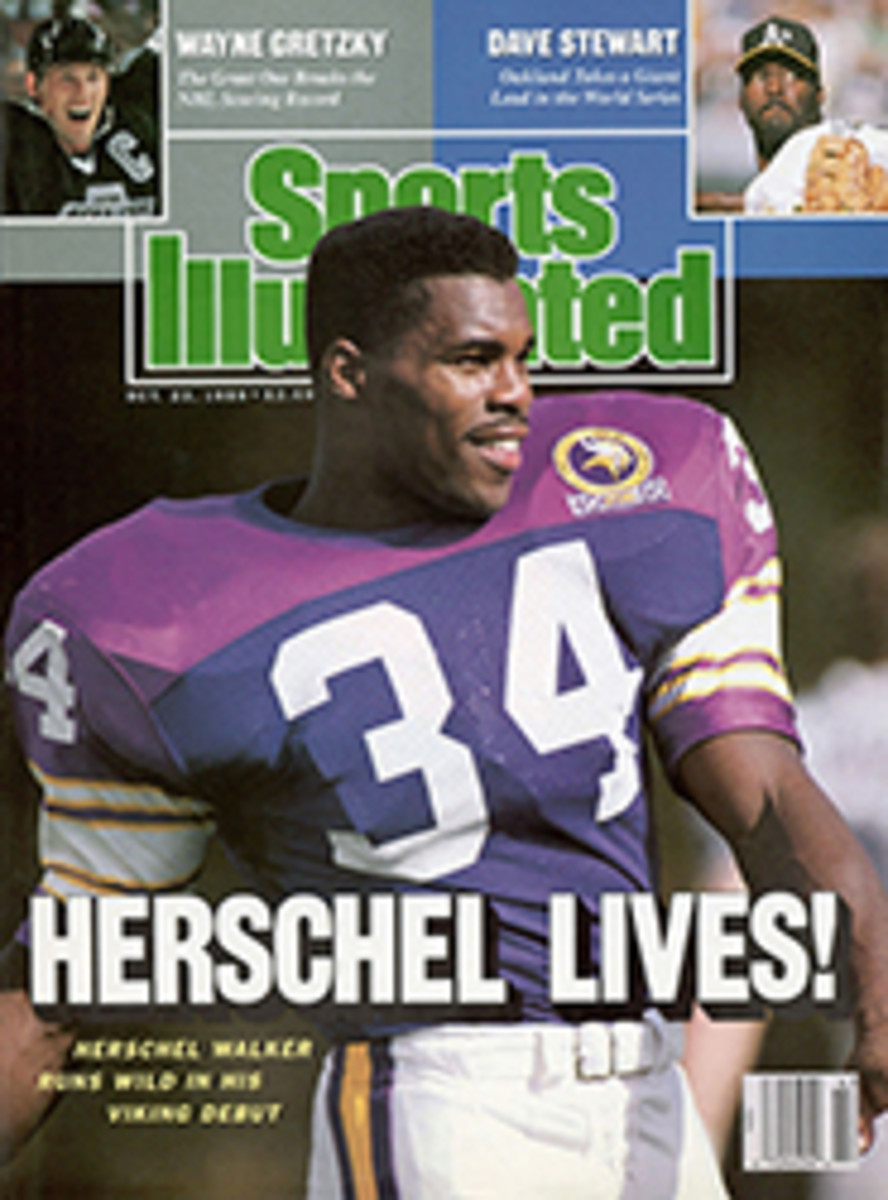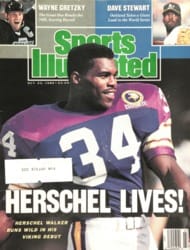
PREPARING FOR LIFE AFTER THE DEATH PENALTY
Two-a-days on the artificial surface at Southern Methodist's Ownby Stadium are guaranteed to make a man dog-weary. The 90°-plus summer Texas heat beats down on the turf. What appears from the grandstands to be a cool green field is actually a hellhole, where the eyes burn with sweat and the throat rasps as one tries to swallow. And when 90 football players are asked to crash into one another repeatedly at top speed, blood flows. These workouts test a man's will, strength and ability—just as they do at each of the other 105 NCAA Division I-A schools. But for me and my SMU teammates in August 1988 the test was especially tough. We could practice, but we could not play another team.
On Feb. 25, 1987, the NCAA had hit the Mustangs' football program with the so-called death penalty, meaning that the school could not field a team in 1987 and would be restricted to seven away games in '88; the school chose not to play again until 1989. An NCAA investigation, in which the university cooperated, had revealed that during the 1985-86 academic year 13 Mustang football players had received a total of $47,000 from boosters, and that eight players had continued to receive an additional $14,000 in the fall of 1986. The NCAA Committee on Infractions stated in its report that the penalty was intended "to eliminate a program that was built on a legacy of wrongdoing, deceit, and rule violations.... Not only is Southern Methodist University a repeat major violator, but its past record of violations is nothing short of abysmal."
The decision rocked and rent the university. Student reaction to the sanctions ranged from fury at its severity to resignation to enthusiastic endorsement. Many professors and administrators were appalled that the reputation of the school could be so besmirched by the venality of its athletic department. The scandal reached beyond Dallas, where SMU is located, when Texas Governor Bill Clements, who had twice chaired the university's Board of Governors, acknowledged that he had approved of illicit payments to athletes. Clements' admission prompted a few faculty members to advocate permanently dropping football at SMU.
Elsewhere, football experts were wondering if the football program would ever recover. Barry Switzer, the coach at Oklahoma at the time, said, "They talk about the death penalty being a two-year proposition, but it's more like a decade or more. It could put you in a doormat status for 10 years, and who can recruit for a doormat?"
Jimmy Johnson, then coach of Miami and now coach of the Dallas Cowboys, said, "If the NCAA wanted to send a message, this one was very loud and very clear. You hate to see something like this happen because innocent people are being hurt."
I assume that Johnson included among those innocent people the dozens of SMU players who never were offered payoffs and saw their college football careers either disrupted or ended. Someone else who would be affected was the coach who replaced Bobby Collins, who resigned shortly before the NCAA issued its penalty. The new coach would have to have impeccable personal and football credentials, and preferably would be an SMU graduate, so that he could speak to his charges about the school's traditions. The job went to Forrest Gregg, an all-conference tackle for the Mustangs in 1954 and '55. Gregg was also the first man to have been in the Super Bowl both as a starting player (for Green Bay, 1967 and '68) and as a head coach (Cincinnati Bengals, 1982). Vince Lombardi called Gregg "the finest player I have ever coached."
I supported the selection of Gregg. I remember that when I was nine I had traveled with my family from my hometown of Piano, Texas, to Canton, Ohio, to watch the NFL Hall of Fame inductions. That was 1977, the year Gregg, who is from Birthright, Texas, was inducted. He seemed larger than life to me then. Today I believe Coach Gregg stands taller than ever.
In March of 1988, the football staff posted fliers in the student center and dining halls inviting anyone interested in playing football for SMU to contact the coaches. On April 4 I showed up at Ownby Stadium to throw passes and run routes for a couple of hours. Those of us who appeared that day were nicknamed the Dirty Dozen Plus One, because we numbered only 13, which suggests how the campus viewed football or, at least, the team's chances of becoming competitive again. We worked out for three weeks before the summer break under the guidance of offensive coordinator Tom Rossley.
When we returned from vacation, we began preseason two-a-days on Aug. 24. Coach Gregg was trying to mold 15 freshman scholarship athletes, nine transfers and an army of walk-ons into a team. As one of those walk-ons, I was more hopeful than confident that I would make the squad as a wide receiver. I had some experience—I had been a part-time starter at Piano Senior High—but at 5'6", 160 pounds I wasn't big enough to be recruited by a major college, and I wasn't that fast, either. So when I graduated from high school, I never thought I would step on a gridiron again. I walked on for a number of reasons, but mainly because I loved to play football. To be honest, it also felt good to be interviewed and photographed, to believe that what I was doing was important to the school and to know that even the media were interested in what we were doing. But there were times when I would not reveal that I was on the team because I was tired of hearing all the comments about how small I was to be playing football.
Our 1988 "season" consisted solely of drills and intrasquad games, three hours a day for two months, with nothing to win. It was difficult to practice for that long without ever seeing an unfamiliar face across the line. The enthusiasm and excitement of preparing to meet an unknown opponent were never there. Consequently, the long, hot practices inevitably became drudgery. The 90 players we began with in August dwindled to 64 by the final workout.
All we had to keep us going was the awareness that we were improving. Indeed, we began to think we resembled a real Division I-A team. But the '88 season ended for me when I dislocated my finger in October. In February I fell and ended up requiring knee surgery, which kept me out of spring practice. I sat on the sideline—and was impressed at the transformation of a band of dreamers into a tough-minded group of athletes shaped under the cajoling and back-patting of coach Gregg. By the end of spring practice, we were confident. Because we didn't have the personnel to outmuscle most teams, coach Gregg installed a run-and-shoot offense and a 3-4 defense. I hoped I would be able to pick up on the offense's more extemporaneous style when I got back into pads.
During practice this past August, I experienced some of the toughest days of my life, and not just because of the physical agony of the two-a-days. I had reinjured my knee in a summer automobile accident, and with every session it was becoming clearer to me that my knee was affecting my play. Finally, I admitted that I was doing neither the team nor myself any good. Giving up the dream of playing Division I-A football was hard, but when I told Coach Gregg, he put an arm over my shoulders and offered me a job as an undergraduate assistant. One of my responsibilities was to help put together the scouting reports on Rice, which has not had a winning season in 25 years. On Sept. 2, we were to meet the Owls in Ownby Stadium for our first intercollegiate game since 1986.
Few words were spoken at practice during the week preceding the game. We were nervous, and it seemed as if game day would never arrive. Then, almost too suddenly it seemed, the game was upon us.
If ever a team received a good omen, SMU did that night. Before a nearly sold-out crowd in the 23,733-seat stadium, we recovered a fumble on the opening kickoff and, seven plays later, Matt Lomenick put us ahead 3-0 with a 23-yard field goal. For the rest of the half we performed the way everyone had predicted we would, and we went into the locker room trailing 28-3. We were far better in the second half, and no one on the team thought the 35-6 final score truly reflected how we had played.
We had an off-week, giving us 14 days to prepare for a home game against Connecticut, a Division 1-AA team. Everyone more or less acknowledged that if we were to win a game this season, this was the likely one, but at the half we were down 23-7. During intermission, Coach Gregg made some adjustments and gave a talk that convinced us that we could still pull out a victory.
With 7:23 remaining, Coach's speech seemed to be wishful thinking. We were behind 30-14, and many of the 20,548 spectators had already departed. The diehards who stayed saw one of the most emotional comebacks in Mustang history. It started with redshirt freshman quarterback Mike Romo completing a 43-yard touchdown pass to wide receiver Mitchell Glieber, a holdover from the 1986 squad. Another Romo completion, this one to running back Jason Wolf, was good for the two-point conversion, and the score was 30-22. After a field goal and a 51-yard drive we were on the Connecticut four-yard line with two seconds showing on the clock. The final play was a pass designed to go to Wolf in the flat, but the Connecticut linebackers had him covered. Romo started to scramble toward the goal line; then, cut off by two Huskies, he stopped. The stadium was hushed as Romo gently lobbed the ball into the hands of receiver Michael Bowen in the end zone—31-30.
Fans ran onto the field to celebrate a win that no one who was there will ever forget. For a few moments I forgot I wasn't playing anymore and ran out and jumped onto a pile of the happiest young men in the world. Coaches leaped and hugged one another. Even the officials got in on the act; seeing the futility of trying to clear the field for a point-after attempt, they let the celebration continue. In the locker room, Coach Gregg was close to tears when he said, "Men, I'm telling you this from the bottom of my heart. I have played in Super Bowls, I have coached in Super Bowls, but I have never felt the way I did when I saw that ball in the end zone."
I am equally sincere when I say that I am grateful to him for keeping me as part of the team. I hope other athletes will get as much out of their college football experience as I have out of mine.
PHOTO
PHIL HUBER
When injuries did in McCreary (red top), Gregg made him a student assistant.
PHOTO
PHIL HUBER
After the Connecticut win, reality set in for Romo (5) and SMU in a 45-13 loss to Texas.
TWO PHOTOS
PHIL STEPHENS
SMU got its first win since '86 by staging the most emotional comeback in school history.
David McCreary, a senior majoring in economics, hopes to attend law school next fall.

